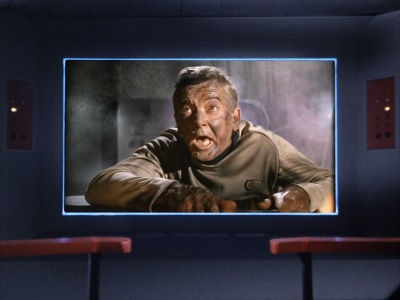Introduction
 This is the "real-world" companion article to Breast Insignia - Regulations, which is written "in-universe" and strongly recommended as a first read.
This is the "real-world" companion article to Breast Insignia - Regulations, which is written "in-universe" and strongly recommended as a first read.
For decades since the conclusion of STAR TREK: The Original Series, fan publications, official manuals, and even subsequent canon have operated on the incorrect assumption that officers' breast insignia represented individual Starships, and that each Starship thus had its own emblem.
In retrospect, that was perhaps the most logical conclusion to draw. The total collection of patches seen on-screen could seemingly not be justified in any better way. Yet, several prominent holes remained in the analysis: especially surrounding the numerous non-Enterprise personnel wearing the "Enterprise insignia" at the Starbase Club in “Court Martial” [1x14] and aboard the U.S.S. Defiant in “The Tholian Web” [3x09].
In January 2013, an unearthed December 1967 memo from the personal files of Gene Roddenberry dropped the equivalent of a nuclear bomb on the previously-assumed insignia system. Within it, producer Bob Justman incontrovertibly stated that all Starship personnel were intended to wear the familiar delta "arrow-head" emblem, and that the Exeter patch seen in “The Omega Glory” [2x25] was entirely a costuming error.
Given Mr Justman's instructions to only remedy the error going forward, it could never have been gleaned from the episodes themselves. Now half a century later, this revelation finally allows for the authoring of an insignia system that accounts for all remaining emblems, and is consistent with their original intentions.
The previous article – Breast Insignia - Regulations – is the result of an effort to do so.
What are your terms?
A special challenge of writing an "in-universe" document is getting terminology as correct as possible, and this formed a study unto itself.
Many terms relating to Starfleet rank and structure that fans currently take for granted are products of subsequent TV productions or non-canon publications that have been retroactively applied to TOS in the public consciousness.
Unfortunately, what "became true" in later Trek doesn't always align with the evidence of what "was true" in the original. Hence, my goal while drawing new conclusions was to base as many of them as possible solely upon the material presented within ST:TOS.
Lines from episodes and the insignia-related descriptors employed by Mr Justman in The Memo were referenced first and foremost. Any conjectural terms that were necessary to fill in detail not provided in dialogue were primarily drawn from regulations of the U.S. Navy — which parallel Starfleet's in numerous observable ways, and were certainly a point of reference used by the multiple military veterans who worked on designing the show.
Breast Insignia vs. Assignment Patches
The overall title of "Breast Insignia" is both an accurate generic description and official Navy term for our subject.
I have specifically avoided referring to emblems as "assignment patches", although that is the heading they currently fall under at Memory Alpha and other sources.
That term follows the idea of ship-specific emblems, yet it was incorrect from the beginning: some breast insignia (e.g.- the "starburst") were never assumed to be assignment-specific, and clearly aren't patches.
To be clear: unit-specific insignia such as the Enterprise shoulder patches worn by Captain Archer and crew on STAR TREK: Enterprise are proper assignment patches; emblems in TOS are not.
The Memo
The need to fundamentally revise our understanding of the ST:TOS insignia system came to light on 31 January 2013, when Harvey at THE TREK BBS posted the following memo sent to costume designer William Ware Thiess from producer Robert H. Justman in consultation with creator Gene Roddenberry:
TO: Bill Theiss
FROM: Bob Justman
SUBJECT: STARSHIP EMBLEMS
DATE: December 18, 1967Whilst sitting in Dailies today, it was noticed that a Starship Captain (from another Starship) was wearing an emblem unfamiliar to yours truly. I have checked the occurrences out with Mr. Roddenberry, who has reassured me that all Starship personnel wear the Starship emblem that we have established for our Enterprise Crew Members to wear.
Doubtless this situation has arisen due to the fact that a different Starship emblem was used last season on "CHARLIE X". However, the personnel of that other ship in that show were the equivalent of merchant marine or freighter personnel -- and therefore not entitled to bear this proud insignia on their individual and collective breasts.
Please do not do anything to correct this understandable mistake in the present episode. However, should we have Starfleet personnel in any other episodes, please make certain that they were the proper emblem.
Under penalty of death!
Signed this 18th day of December, in the year of our Lord, 1967, by
ROBERT H. JUSTMAN
Chief InquisitorCC: Gene Roddenberry
John M. Lucas
D.C. Fontana
Gregg PetersRHJ:sts
P.S. A carven "I'm sorry!" will be sufficient.
R.H.J.
Harvey stated in a further post that The Memo was found in a box and folder devoted to wardrobe items, not a particular episode
.
However, The Memo is certainly in reference to the Exeter insignia. The date (18 December 1967) places it within the shooting schedule for “The Omega Glory” [2x25], which according to Memory Alpha was filming 15 - 26 December 1967.
Research Notes
My original intention was for the Breast Insignia - Regulations article to communicate its explanations through footnotes, but the required number quickly exceeded sensibility.
This section contains research notes and other background information, with sub-headings corresponding directly to those in the previous article:
Overview
- The fictitious title "Starfleet Uniform Regulations" is based on the real-world text entitled U.S. Navy Uniform Regulations.
-
The given year of 2266 is a fairly-accurate estimate. Captain Kirk's original 5-year mission is either 2264-2269 or 2265-2270, depending upon your source.
Unquestionably, “Where No Man Has Gone Before” [1x01] takes place in the first year of his command. Memory Alpha suggests that the Cage/WNMHGB uniforms began to be phased out in 2265 (See: Starfleet uniform (2250s-early 2270s)), and there is no case to say that's incorrect.
I further used the logic that TOS parallels us 300 years in the future. With the "Cage" uniforms being used in the WNMHGB pilot when it filmed in 1965 and the "TOS" uniforms appearing in subsequent regular season episodes that filmed and aired in 1966, I settled upon 2266 as the year that the new uniform regulations officially came into force.
-
A service uniform is the equivalent U.S. Navy uniform variant to the so-called "standard duty uniforms" that we see worn throughout TOS. It is the term I have employed, as no official name for these was ever spoken on-screen. I believe "standard duty uniform" only entered the common vernacular due to the non-canon "STAR FLEET TECHNICAL MANUAL" (1975) by Franz Joseph.
Dress Uniforms (including Full Dress Uniforms) are referred to as such in dialogue on several occasions, demonstrating that Navy uniform terminology is in effect on the formal side of things.
Otherwise, the closest we get is Kirk ordering "standard dress" in “The Savage Curtain” [3x22], which in context was obviously not a reference to an official uniform variant, but a casual way of ordering the crew back into their usual uniforms for the following scene.
N.B.- A more detailed analysis of uniform variants is available within the Officer Rank Insignia article.
Traditional Nomenclature
It is clear from various dialogue that terrestrial words have endured into the 23rd century, and that their definitions have expanded to encompass mankind's own expansion into space, rather than being replaced by "space age" terms that may be more technically accurate.
All three examples given ("ground", "field", and "marine") are canon, and further explained in the appropriate sections below.
Authorised Insignia – Emblems
The words insignia, emblem, and device are all used with consistent meanings in the regulations:
- Insignia refers to the breast insignia as a whole.
- An insignia's emblem is its overall shape or symbol, which indicates assignment type and category.
- Some emblems (namely the Starship "arrow-head") further require that a device be embroidered upon them to indicate Division; others (such as the ground assignment "starburst") do not.
This naming scheme is consistent with the verbiage used by Bob Justman in The Memo, which states: all Starship personnel wear the Starship emblem
.
For that to be true, the delta "arrow-head" shape itself must be the Starship emblem — which is then combined with an embroidered star, globe, or spiral device to form a completed Starship insignia for the Command, Sciences, or Services Division, respectively.
Starship - Commissioned Officer
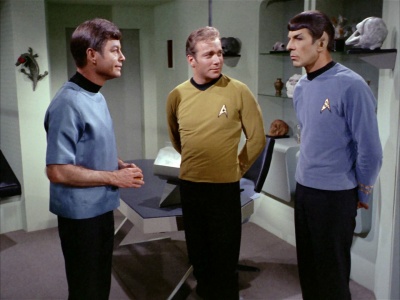
As the key emblem upon which The Memo focuses, there is ironically little to add here.
One important note, however, is that the revelation of the previously-assumed "Enterprise emblem" as being the Starship emblem is not meant to suggest that it was also Starfleet's emblem.
The TOS-era Starfleet emblem is actually the "boomerang" symbol that can be seen painted in yellow on the sides of the Enterprise, and in a physical polished metal form hanging behind various admirals on viewscreens.
For correctness, post-TOS Starfleet history should now record that the Starship emblem (not the Enterprise emblem) was eventually adopted as the symbol for all of Starfleet. However, this is a purely technical change: there is no reason why history should not continue to record that the successful exploits of the NCC-1701 were the catalyst for the decision.
Ground Assignment - Commissioned Officer
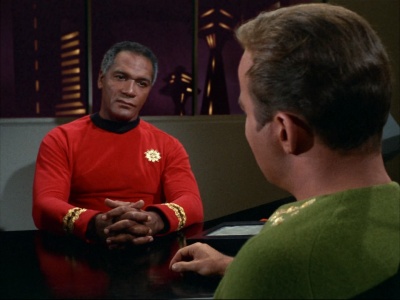
The term ground assignment is still in common use but no longer purely in reference to terrestrial soil, as discovered through two lines of dialogue in “Court Martial” [1x14]:
STONE: I'm telling you, Captain, either you accept a permanent ground assignment, or the whole disciplinary weight of Starfleet Command is going to light right on your neck.
...
JAMIE: Make him take a ground assignment.
This emblem largely speaks for itself over the course of the series; however, my comment about it being often associated with the admiralty of Starfleet Command was a backhanded acknowledgement of the various sources that have written it up as the Starfleet Command Insignia.
Interpreting the starburst as a command-level emblem is simply too narrow, unless the definition of "Starfleet Command" was intended to be much broader than the admiralty.
The most prominent bearers are commodores and admirals, but we clearly see it on the uniforms of Ensigns and Lieutenants in various episodes, including:
- “Court Martial” [1x14]: Lieutenant Areel Shaw from the Judge Advocate General's office as well as the un-named court clerk (Ensign-grade).
- “The Menagerie, Part I” [1x15]: Ms Piper (Ensign-grade) on the staff of Commodore Mendez, Starbase 11.
On a costuming note, these insignia were originally created from filigree flower beads. I followed the trend of describing the emblem as a "starburst", which seems more fitting in a Starfleet context and is probably derived from a similar design of vintage filigree bead known as a "sunburst". Intentional or not, one must acknowledge a certain amount of Wardrobe department humour in having officers on ground assignment wearing flowers.
Field Command - Flag Officer
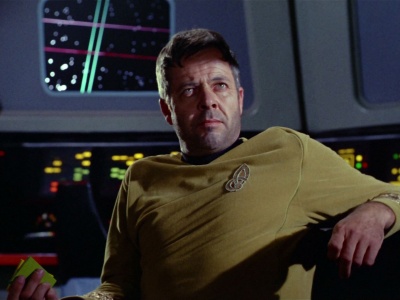
Commodore Decker's breast insignia became a point of much debate after The Memo was unearthed. Unfortunately, many fans immediately dismissed it as "another error" or "something Bob Justman must have missed", simply because it wasn't given any mention.
More likely, Mr Justman didn't mention it because it wasn't applicable to the point he was making.
There is no direct evidence that Commodore Decker's insignia was anything but deliberate, and it is a grand assumption to believe that a detail-oriented producer (who easily recalled one scene with the Antares personnel over a year prior) would have missed what a pivotal character was wearing for most of an episode earlier that season.
The uniqueness of Commodore Decker's insignia corresponds to the uniqueness of the character. In the entirety of TOS, he is the only instance of a flag officer with a field command.
Obviously such an officer would not be wearing the ground assignment "starburst" — but it is important to understand why he wouldn't be wearing the standard Starship "arrow-head" either.
Historically, the rank or title of Commodore indicates "a senior Captain whose authority extends to multiple ships". It is a "one star" rank that may or may not be afforded the same flag status as admirals within various navies, but is indeed a full flag rank in Starfleet (explained in Officer Rank Insignia).
Thus, while Commodore Decker is the commanding officer of the Constellation, he wears a unique breast insignia because his level of command authority as a flag officer places him at the force or squadron level, above that of a single Starship.
With Starfleet's primary mission being non-military, Commodores and Admirals commanding forces in the field would naturally be a rarity. However, the plot events of “The Doomsday Machine” [2x06] necessitated such a character in the script. Had Decker been ranked a Captain as Kirk was, his assignment would have been limited to his own ship, and he would not have had the authority to commandeer the Enterprise.
There is further production evidence to say that Decker's insignia was intentional: the screen-used patch is an emblem that bears absolutely no device (star, globe, or spiral). Some publications added devices after the fact, having assumed that it was the "Constellation insignia".
Conversely, the Wardrobe department ensured that devices appeared on the patches of all ship-assigned officers throughout TOS. Command Stars can be observed on the Merchant Marine patches of the Antares crew and on Captain Tracey's "Exeter patch", while a Sciences Globe was on the "Exeter patch" of Dr Carter.
To assume that Commodore Decker's insignia is another erroneous "ship-specific assignment patch" is not only to assume that Mr Justman missed it, but that it was the sole occasion on which the wardrobe department also missed applying a feature that they were otherwise consistent with.
Starfleet Academy - Cadet

Unfortunately, Finnegan in “Shore Leave” [1x17] is the only significant cadet character to appear in the entirety of ST:TOS.
However, we are at least provided with enough information to make several conclusions:
- Although Finnegan is a vision from Kirk's academy days, we know that his silver-grey shirt remains current, due to cadets making brief background appearances in other episodes. (Interestingly and probably unintentionally, this means that cadets wore the distinctive black V-neck collar at least a decade before officers traded their ribbed turtle-necks for the same feature!)
- With endless other options available, we presume that the cadet breast insignia being a smaller version of the ground assignment insignia was a deliberate choice made by the Wardrobe department — and makes utter sense, as Starfleet Academy would be a ground facility.
- Given that all cadets are identified by the same distinctive uniform colour and none are known to wear rank insignia, we must further presume that they are not considered to have a specific department until receiving assignment as commissioned officers.
N.B.- During ST:TOS, those at the Academy are referred to interchangeably as both cadets and midshipmen. For further analysis of those terms and their distinction, please see: Officer Rank Insignia.
Merchant Marine - Licensed Officer

The Merchant Marine is yet another area in which traditional terms are established as continuing into the future.
In The Memo, Bob Justman equates the Antares crew to merchant marine or freighter personnel. In the opening Captain's Log of “Charlie X” [1x07], that ship is described as a cargo vessel
.
The first verbal mention of the merchant service comes in “Bread and Circuses” [2x14]:
SPOCK: SS Beagle. Small class four stardrive vessel. Crew of forty seven, commanded by... Jim, I believe you knew him. Captain R M Merik.
KIRK: Yes, at the academy. He was dropped in his fifth year. He went into the merchant service.
Finally, the Merchant Marine is named fully in “The Ultimate Computer” [2x24]:
M5: Geologist Carstairs served on merchant marine freighters in this area. Once visited planet on geology survey for mining company.
From the dialogue and ship descriptions, it is clear that the Federation's merchant service is analogous to the United States Merchant Marine, which Wikipedia defines as being primarily responsible for transporting cargo and passengers during peacetime
. (The further statement that in time of war, the Merchant Marine can be an auxiliary to the Navy, and can be called upon to deliver military personnel and materiel for the military
was also included, as it is simply logical.)
It is also certain that the Merchant Marine is its own separate service and not part of Starfleet, given that Captain R M Merik went into the merchant service after being dropped from the Academy. (Unfortunately, this means that the effects team responsible for remastering ST:TOS in HD erred in putting Starfleet's "boomerang" insignia on their CGI model of the Antares, which did not appear at all in the original opening sequence of “Charlie X” [1x07].)
The Wardrobe department also took pains to make the Antares personnel visually distinct from Starfleet's, notwithstanding the re-use of old Cage/WNMHGB-style uniforms from stock. The breast insignia emblem is drastically different from our familiar Starship insignia, and the design of its embroidered Command Star also differs significantly. Moreover, they opted not to pull gold shirts for Captain Ramart and his first officer, but instead chose khaki-beige (or "camel") for the Command uniforms of the Merchant Marine — being that it had by this time been eliminated from Starfleet's colour scheme.
Divisions, Line Officers, and Staff Officers
Divisions
The currently-accepted term "Division" is another retroactive one that was not established on-screen in ST:TOS, but since the word used here has no direct effect upon our core purpose of re-defining the proper meaning of the emblems, I acquiesced to using it for easier readability.
In reviewing the Breast Insignia - Regulations article, the reader could mentally replace the term Division with Community or Branch, and would be just as much (if not more) correct.
The problem with Division is one of confusion: the term is already in standard Navy use, and is a shipboard unit smaller than a department. The only reference to a division was Mr Scott in the TOS pilot “Where No Man Has Gone Before” [1x01] stating Engineering division ready, as always
. That line should most correctly have referenced the Engineering department, but his usage was nonetheless in line with what a naval division is generally expected to be.
Interestingly, according to the List of Naval Officer Designators at Wikipedia, Command/Sciences/Services are most correctly Communities – a word which already reflects the cooperative, non-military natures of Starfleet – yet that term would likely seem odd to many fans who wouldn't be aware of its naval context.
In my opinion, Branches is the best term, and should have been used all along. Starfleet is described as a combined service
by Captain Kirk in “Tomorrow is Yesterday” [1x21], yet the Army, Navy, and Air Force branches of the Armed Forces as we know them today do not exist within it — thus leaving this term appropriately open and available for futuristic re-interpretation.
Line Officers and Staff Officers
Line and staff officers as we currently understand them do exist within Starfleet, confirmed by the following dialogue in “A Taste of Armageddon” [1x23]:
SCOTT: What would you suggest?
MCCOY: Me? I'm a doctor. If I were an officer of the line, I'd--
SCOTT: Would you have me open fire?
Interestingly, U.S. Navy Sleeve Designs for Line & Staff Corps specifies that Line Officers wear a star while Staff Corps Officers wear the device of their particular corps — directly analogous to what we see on Starship insignia for the various Divisions!
While we can assume that Command Division officers are trained as Line Officers to exercise general command authority, it is clear that line officer training is not exclusive to the Command Division and is optional for Staff Corps Officers. We regularly see Montgomory Scott (Lieutenant Commander / Chief Engineer) taking command of the Enterprise, but never Leonard McCoy (Lieutenant Commander / Chief Medical Officer).
Conversely – while the primary purpose of Staff Corps Officers in the Sciences and Services Divisions is to serve as specialists in their career fields – we see that specialisations also exist in the Command Division (e.g.- Specialist Tomlinson manning phaser control in “Balance of Terror” [1x08]).
Division Colours and Devices
The key question of terminology for this section was: "If the insignia is the breast insignia as a whole and the emblem is its overall shape or symbol, what then is a distinctive name for the star/globe/spiral that gets embroidered onto Starship patches?"
Neither dialogue nor The Memo seemed to contain an answer, hence the analogous term device was pulled from U.S. Navy uniform regulations.
Nurse – Light Blue / Red Cross

While I believe the Command/Sciences/Services descriptions in the Breast Insignia - Regulations article are self-evident, the one for Nurses bears further explanation.
To begin with some Earth history: the United States Navy Nurse Corps was established in 1908 and remains a separate corps from the Medical Corps, with its own corps device. Moreover, during the World War II era in which Gene Roddenberry and his contemporaries served, the Navy Nurse Corps was led by a superintendent. Its nurses had no permanent commissioned rank during that time
. Nurses were afforded "relative rank", with the Superintendent and Assistant Superintendent equating to Lieutenant Commander and Lieutenant, while Chief Nurses and Nurses equated to Lieutenants JG and Ensigns. Furthermore until 1942, nurses were authorised only indoor white uniforms (similar to civilian nurses).
Albeit that they aren't in white (it's a terrible choice for film), on-screen evidence shows that many of these ideas were applied to nurses in STAR TREK.
The unique light blue uniforms worn by Nurse Chapel and others are nurse uniforms — not "women's medical uniforms", as they are sometimes misinterpreted to be. Dr McCoy wears the same blue service uniform and Starship Sciences insignia as Spock, and a female doctor would therefore wear the standard women's service uniform in the same manner. The red cross device on the nurse's breast insignia cinches the argument, as Dr McCoy is never seen with one, and continues to wear the sciences globe even when donning his medical scrubs.
There is even a piece of dialogue that alludes to the separate status of the Nurse Corps in “For the World is Hollow and I Have Touched the Sky” [3x10]:
CHAPEL: I am a nurse first, Doctor McCoy, and a member of the crew of the Enterprise second.
MCCOY: You're excused. You may return to your quarters.
CHAPEL: No, I'm sorry, Doctor. I've called the Captain and I'll wait until he comes.
This definite separation of Nurses from other Sciences Division personnel and the existence of a unique breast insignia means that the Nurse Corps may be listed as a "fourth division" of Starfleet — but ostensibly so, given that nurses perform their daily service under the auspices of the Medical Department.
Additionally, all nurses appear to be Ensign-grade. This furthers the argument that they are a separate corps, and also introduces the concept of "limited duty officers", who are only eligible for promotion within their own corps.
Whereas it is true that Staff Corps Officers such as Dr McCoy don't necessarily have line officer credentials either, they must still receive an appropriate level of officer training at Starfleet Academy to enable them to receive promotions and command within their own departments. Nurses, on the other hand, are the front-line care givers to ill and wounded officers, not department heads.
We assume that the Nurse Corps must have superintendent or director positions into which senior nurses can be promoted at Starfleet Command, but in terms of shipboard service, it makes utter sense that the thrust of Starfleet would not be to train nurses fully as commissioned officers, but to give the best medical personnel the education they need to serve onboard a Starship and get them into the sick bays promptly.
Divisional Consistency
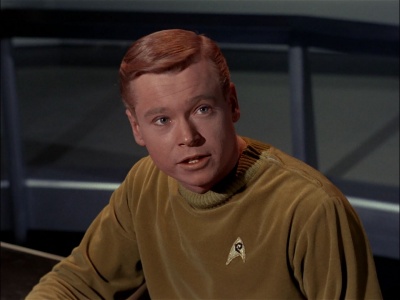
This section was little more than a footnote, as pilot episodes are the production equivalent of a "shakedown cruise", and significant format changes are still to be expected if a series is picked up. Furthermore, the focus of these articles is upon TOS-era uniforms, not Cage/WNMHGB-era uniforms.
Nonetheless, I wanted to give some in-universe acknowledgement to the numerous combinations of Division colours and patches seen in footage from “The Cage” [0x01] (via “The Menagerie, Part I” [1x15] & “The Menagerie, Part II” [1x16]) and in “Where No Man Has Gone Before” [1x01]. These were shown in TOS Season 1, yet filmed prior to the start of regular production, after which more consistency could be expected.
Additionally, Spock as first officer changing from a Command uniform (2nd pilot) back to a Sciences uniform for the remainder of the series was well worth addressing in some manner.
Frontier Guard - The "Other" Insignia
The most astute viewers have by this time asked: "What about these?"
It can be said with near-certainty that these are not Starfleet officers, or uniforms. Here the Wardrobe department deliberately avoided the familiar and took similar steps as were used to differentiate the uniforms of the Antares (Merchant Marine) personnel, utilising a unique colour and breast insignia. These are even further removed in that they are devoid of any rank braid corresponding to the stated ranks of the wearers, and thus do not convey a naval tradition.
The two appearances of this uniform in TOS correspond to the only two occasions on which we see outpost personnel: those being Commander Hansen of Earth Outpost 4 in “Balance of Terror” [1x08] and Lieutenant Harold at the Earth Observation Outpost on Cestus III in “Arena” [1x19].
While names such as Starbase
and Space Station
are given to other installations visited by the Enterprise, the term Outpost is used specifically in reference to those serving a defence/observation role on the Federation (or other) border.
These officers are therefore part of another auxiliary service: the Federation's border guard. It's a generic term, according to the linked Wikipedia article:
In different countries, names of particular border guard services vary significantly. The service may be called "police", "guard", "troops" or "sentinel" and the name would refer to the nation's official term for the state border - whether it is "frontier" or "border".
Naturally in a STAR TREK context, I prefer "frontier"!
Fittingly, the border guard uniforms bear resemblance to Starfleet uniforms in much the same way that modern-day police and guard uniforms share certain design elements with military uniforms, yet generally have their displays of rank more muted.
Although the overall authority at the Outpost on Cestus III was Commodore Travers (who we assume was a Starfleet officer but never actually see on-screen), this does not in any way detract from the idea of an Outpost being staffed with frontier guard.
We also know from episodes such as “Bread and Circuses” [2x14] that even those who got dropped from Starfleet Academy could still have productive careers in the Merchant service. It is difficult to believe that other officers successfully complete years of rigorous training and graduate from the Academy for the purpose of sitting on a remote outpost watching the border.
The existence of these uniforms necessitated their analysis here for completeness. However, they were omitted from the Breast Insignia - Regulations document, and don't affect the correctness of its contents.
New Advantages & Possibilities
The Memo has unfortunately been met with anger and rejection by a portion STAR TREK fans who were particularly enamoured with the one-emblem-per-ship idea, yet the clarity of its message does not leave much room for argument.
However, the purpose of this and its component 'regulations' article is not to decry adherents of that system — but rather to help educate fans about the original intentions of the producers of TOS, and demonstrate that a logical self-consistent insignia system can be authored from them.
Due to the fact that subsequent STAR TREK productions also made the "one emblem per Starship" assumption and based their canon upon it, we now arrive at a situation where there are in fact two concurrent canon insignia systems pertaining to the era of The Original Series. In being able to choose according to one's preference, fandom has lost little and gained a great deal.
For the multitude of TOS-era fan groups and independent productions that have come into being, it is perhaps not as important which system they employ, so long as they are able to make an informed choice and remain self-consistent within their own designs.
Moreover, with the ever-increasing popularity of attending conventions and "comic cons" in costume, the greatest benefit is perhaps to Starfleet uniform aficionados. Consider that if the arrowhead is the Enterprise emblem, then any fan who wears it is restricted to playing only the crew members of that one particular ship (and if you are wearing captain's braid then you are wearing "Captain Kirk's uniform", period). Knowing that it is and always was the Starship emblem makes this beloved insignia genuinely available to any fan playing any character on any ship in Starfleet – without the need to change over to a new patch.
Furthermore, a new understanding of Commodore Decker's insignia offers great possibilities for both costumes and stories in the largely-unexplored area of Starfleet flag officers commanding in the field.
Further Reading
If you still have not read the Breast Insignia - Regulations article, this would be a good time!
For a supplementary guide to rank insignia, please see: Officer Rank Insignia
Acknowledgements
- Extreme gratitude to Harvey at THE TREK BBS for finding and posting The Memo!
- Star Trek: TOS screencaps from TrekCore.
- Departmental Symbol and Exeter images from STAR TREK Classic icons.
- Chrissie's Transcripts Site, which was searched extensively for "in-universe" terminology.

